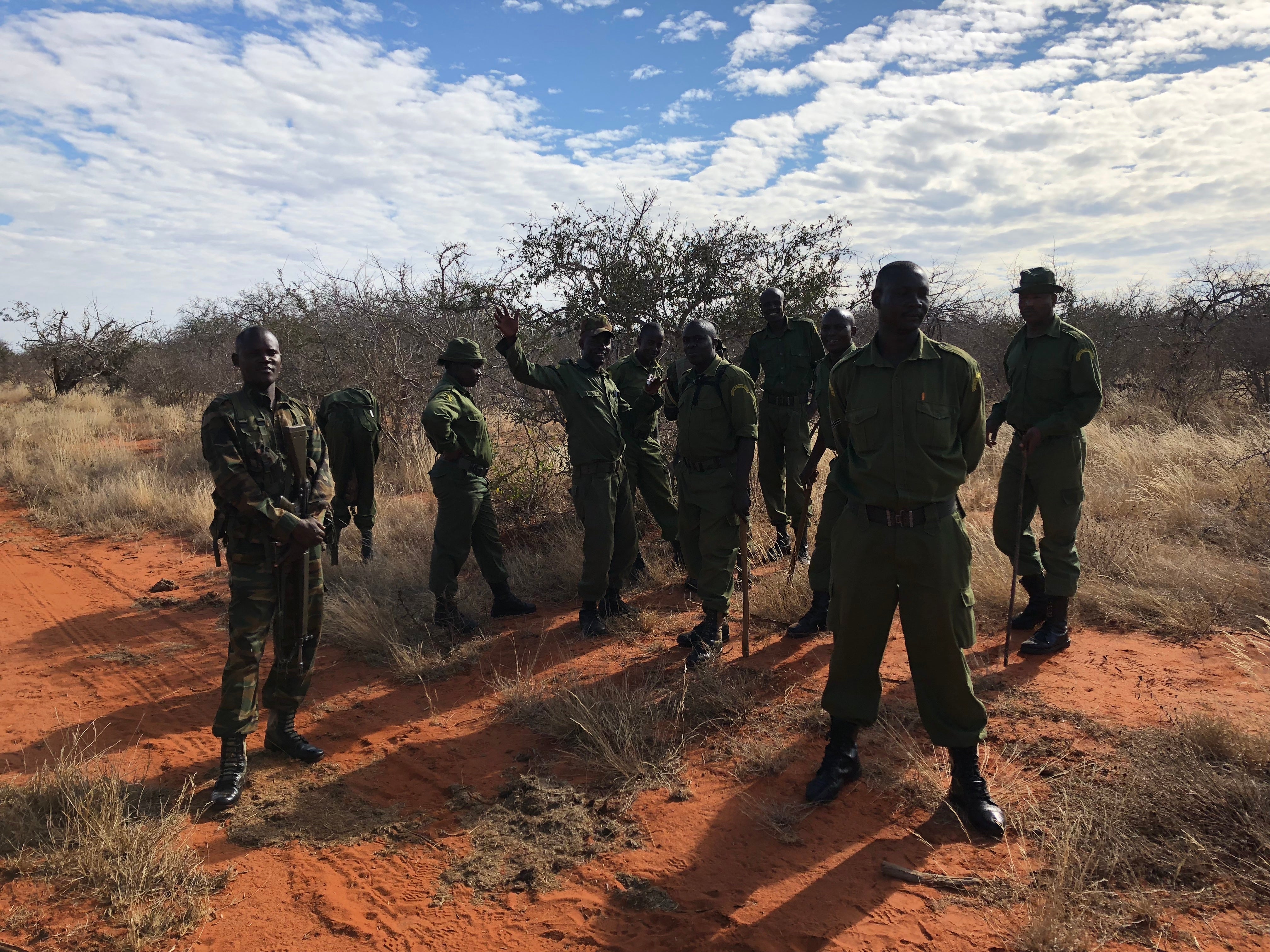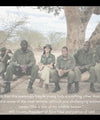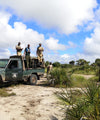Recent Post

My Walk with Rangers 2018
This article is for Raabia, Eregai, Muhammad, Joseph, Mike Renson, Omar, Gaddafi, Kirui, Kikon Jackson and all the other rangers I had the chance to get to know during my walk with rangers.

They are all passionate about their jobs, they are proud contributing all what they have, they are all driven by the love of wildlife more than by any other rewards - it was an eye opening experience for me to join them!
LIFE AS A RANGER
How does a life of a ranger look like? This is super difficult to explain, ideally, you experience it yourself and you join a walk with rangers.
What drives those people?
"I love my country - Kenya is its wildlife and it's people - protecting wildlife means protecting my country" (Kikon Jackson, my friend from Amboselli)"

The ranger insurance report 2016, found that just 60 percent of rangers had health insurance, 50 percent had life insurance and 40 percent had long-term disability insurance.
I discussed this topic with Raabia on my last day during lunch while we were talking about her new project – she is setting up her own ranger unit. From the politics behind, the recruitment process, the wages, insurances to trainings, etc.
All of that contributes to a good morale of the rangers and morale plays a massive role in reducing poaching.
Morale was also a topic during my time in the bush - not because of insurance issues but because of post-traumatic stress disorder triggered by the death of their comrades and friends in the field.
I tried to summarize all my impressions by mapping out a typical day I had during my walk with rangers:
We have been between the national parks Tsavo East and Tsavo West.
Animals pass this area on the way from one park to the other. During this transfer, there is a high risk for interactions with humans and the animals are not as well protected as in the parks.

05:30am - the early bird catches the worm - some morning Yoga & stretching before sunrise
06:00am - waiting for the sunrise - but worth it, don't you think so?

07:00am - Breakfast and chai - I made it my morning routine to enjoy this breathtaking scenery
08:00am - Briefing and departure to our patrolling area
08:30am -05:00pm - patrol with diverse tasks (details below)

Rangers use GPS to track animal movements, record other incidents like illegal logging spots or charcoal kilns. Along the way, we looked for poaching activities and snares that can seriously injure or even kill animals. We collected and destroyed them.
About poaching
Kenya is home to many national parks and national reserves that have provided a home to tens of thousands of elephants and thousands of rhinoceros. The Amboseli, Tsavo East, and Tsavo West National Parks, as well as the Maasai Mara National Reserve, are among the most popular tourist destinations in the country and help bring in hundreds of thousands of local and international visitors each year. In a 2013 annual report, the Kenya Wildlife Service (KWS) reported 302 elephants were lost to poaching that year. However, according to the census cited in that annual report elephant populations within KWS-monitored areas were steadily growing and in 2013 had reached 1940 individuals. The country is known to have lost 137 elephants and 24 rhinoceros to poachers in 2014. The total elephant population within Kenya is estimated at roughly 38000 according to the KWS annual report of 2012.
KWS operates in many of the national parks and national reserves throughout Kenya and helps to coordinate cross-border information sharing and operations with Tanzanian wildlife agencies as well as other anti-poaching groups.
Experiencing poaching firsthand - Can you see them? Two snares for bigger game

Here some example for smaller animals
We found more than 50 wire snares & traps that day
Trophy tree at one of the ranger camps - think about the amount of killed animals those traps would have caused

Illegal logging
Kenya loses around $10 million annually due to the illegal cross-border wood trade with Tanzania, while Tanzania loses more than $8 million, according to studies cited by the World Wildlife Fund (WWF).
An additional report done by United Nations Environment Program (UNEP) and Interpol has shown that Kenya loses 70,000 hectares of forest each year to illegal logging.
Most of these organized crime networks are either focused on charcoal or high value logs for export particularly to Asia.
Interpol cites the coastal city of Mombasa as a reloading point for the illegal logging trade.
“Kenya, with its port in Mombasa, is a significant transit point for a lot of timber — and a lot of illegal timber — moving from other parts of Africa before heading on to Asia and also the Gulf states,” according to Davyth Stewart (Interpol’s Environment Security Program.
We found this pile of wood ready for charcoal production

We even caught an illegal logger. Interrogation starts, typical ranger business. After documenting everything the hard work started - we had to destroy everything

Next step - destroying everything. Piling up wood, collecting grass, lightening it up.

Collecting all the chopped wood takes time and is a super sweaty business
About charcoal farming
As mentioned above, this topic is closely linked to illegal logging - charcoal is one of the biggest informal businesses in Africa. It provides energy for approximately 80 percent of urban and 35 percent of rural households - it is the fuel of choice in the absence of electricity or gas.
According to the UN, Africa accounted for three-fifths of the world’s production in 2012 - and this is the only region where the business is growing. It is a slow-burning environmental disaster!
Illegal charcoal…
harms the environment - destroys the forest as a refuge for different species. The trees store water, which is useful in such a parched region. Deforestation supports desertification and finally it fuels war and terrorism - militias like the al-shabab funds itself partly through their share.
After an incoming report, the rangers raided a house in a community

Same logic as with the timber - collecting, making notes, and destroying it

Continuing the patrol watching out for illegal logging activities or active charcoal kilns - as you can see, they tried to hide the smoke below a tree


If you think destroying timber is exhausting, you should try destroying a kiln. Hot, smoky, dusty and sweaty business - but I loved it. I'm always "hands on"!
We destroyed several kilns, after destroying this one we continued with our patrol. We found motorbike tracks and followed them for hours through the bush….
…and it paid out, we caught three persons transporting charcoal without having the papers (for ownership, transport, etc.)



In total, I have been in Kenya for 2 weeks, 12 days in the bush. It was a mind-blowing experience. Witnessing the beauty of wildlife and the rangers fighting for it every day while being exposed to so many threats and challenges made me think. It took me quite a while to process everything though I would recommend every one of you to go there and experience it by yourself!
!!!If you have questions, don’t hesitate to contact me directly!!!
Best regards,
Steffen
















5 comentarios
acniqyfeqc / Mar 25, 2021 at 05:00
Muchas gracias. ?Como puedo iniciar sesion?
HcxUVjOzLsYBaSN / Aug 18, 2020 at 06:19
GFBeraWHfRkPiM
fIgXCKwBQVZJSsA / Aug 18, 2020 at 06:19
aOlMTJhfCjkD
YgQhROFVucMCDxB / Jul 28, 2020 at 16:06
XaqjZbur
urjWsYfPFAnR / Jul 28, 2020 at 16:06
BUFSNQDXWHl